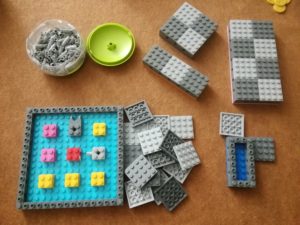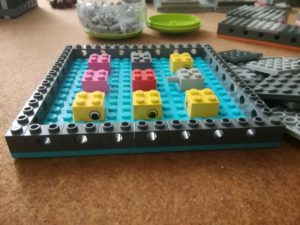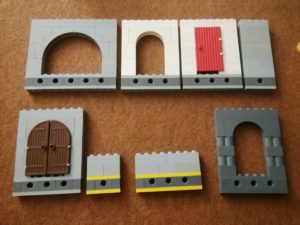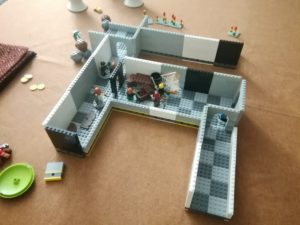Details about my LEGO Pathfinder Campaign
So, a few people have asked me for details about the builds I am using in my Pathfinder game. I will attempt to give them here. 🙂
I tried to combine “What will look good” with “What is affordable”. Sometimes price won out, sometimes looks did. Overall I’ve sunk $200 into the project so far, beyond the LEGO I already had on hand.
I settled on 4×4 plates to serve as 5′ squares. This gave a starting scale to everything. It’s not perfect but it works alright. I did not have enough of these plates on hand so I bought about 300 each in light bluish gray and dark bluish gray.

The plates I used for the subfloor I already had on hand in various sizes. But if you do not have large plates don’t worry, I found that 8×8, 4×8, and 12×8 are the best sizes, This allows the checkerboard pattern to always be lined up properly. I bought around 1000 technic pins to make the connections. (I store these in X-pods which I think are terrific little holders)

I bought around 2000 1×2 technic-hole bricks to use for the connection edges. This granted me three benefits. #1 1×2’s were cheap, very cheap. #2 The connections would always be properly spaced. (Every checkerboard would always have a technic hole in the center) #3 I could always use the 1×2’s in any size floor piece I wanted to make regardless of how big or small it is. (I made one piece of floor that is 32×32 studs from 4x 16×16 plates and 2×4 brick internal supports/connectors. It turned out surprisingly tough)
I used “extra” bricks to fill in the center that holds up the floor tiles since these will never be seen (odd colors, odd brand blocks, pieces with connections I never use, etc,)

After making what I hope is enough flooring I moved on to the walls. I figured 7 bricks high would be enough. I also made short walls for one side to allow the players to more easily see into the setup, and move their minis. Along with that, I made archways and doors which allow a 1-brick offset between rooms so I don’t deal with 2 walls trying to take up the same inside corner point.
I bought several thousand 1x# plates in yellow (due to it being cheapest) and used them for the short walls. This allows me to know what piece is intentionally a short wall, and what piece has broken apart in the bucket of walls.
I used solid colors on the walls for the moment, but eventually, I plan to break all the walls apart and rebuild with random colors. I decided against using red/blue/yellow for the walls simply because it didn’t look very good at all. But I also had enough grays/black/white on hand to use. If I didn’t have what I did I would probably do something like this: http://www.legogm.com/2015/05/lego-terrain-101.html and only use bright colors if I had no other option.
I will likely add wall-decorations later like torches, paintings, etc.

And here we have a finished map with the campaign well underway for it’s first adventure session.
Thanks!

